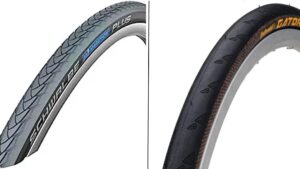How To Cycle Safely On Wet And Slippery Roads

Master cycling in wet conditions with safety tips, gear recommendations, and maintenance insights. Conquer slippery roads like a pro.
*This article may contain affiliate ads that help to support this site*
Cycling enthusiasts, both casual riders and dedicated cyclists, understand the thrill of the open road. But when those roads become wet and slippery, a new set of challenges arises. Rain, puddles, and wet leaves can turn a relaxing ride into a potential safety hazard. That’s why it’s crucial to master the art of cycling in adverse weather conditions.
In this article, we’ll explore how to navigate wet and slippery roads like a pro, ensuring your safety and enjoyment during every ride. We’ll cover essential gear, bike maintenance, riding techniques, visibility tips, and route planning. Whether you’re commuting, training, or just enjoying a leisurely ride, these insights will help you confidently tackle wet conditions. So, fasten your helmet and prepare to conquer the elements!
Understanding The Risks
Cycling in wet and slippery conditions presents a unique set of risks that every cyclist should be aware of. By understanding these hazards, you can take proactive measures to stay safe on the road.
One of the primary risks is reduced traction. When roads are wet, your tires have less grip on the surface. This reduced traction makes it easier to skid, especially when accelerating, braking, or cornering. As a result, you may lose control of your bike, which can lead to accidents or collisions.
Decreased visibility is another significant risk. Rain and spray from passing vehicles can impair your vision, making it more challenging to see obstacles, road signs, and other road users. This reduced visibility not only increases the likelihood of accidents but also hampers your ability to anticipate and react to potential dangers.
Moreover, wet roads often mean longer stopping distances. Your brakes may take longer to engage fully, increasing the time it takes to come to a complete stop. This poses a danger when encountering sudden obstacles or intersections.
It’s important to be mindful of these risks when cycling in the rain. The first step to staying safe is acknowledging the challenges and adapting your approach to mitigate them. In the following sections, we’ll delve into the strategies, gear, and techniques that will help you navigate wet and slippery roads like a pro, minimizing these risks and maximizing your safety.
Essential Gear And Equipment
When it comes to cycling in wet and slippery conditions, having the right gear and equipment can make all the difference in staying safe and comfortable during your ride. Here’s a rundown of essential items every cyclist should consider:
1) Waterproof Clothing: Invest in high-quality, waterproof cycling clothing to keep yourself dry. A good waterproof jacket and pants will shield you from rain and wind, while waterproof shoe covers can keep your feet dry.
2) Fenders: Fenders are a simple but effective addition to your bike. They prevent water from splashing up onto you and your bike, keeping you drier and more comfortable.
3) Waterproof Gloves: Your hands are exposed to the elements, making waterproof gloves crucial for maintaining a good grip on the handlebars and staying warm.
4) Waterproof Bags or Panniers: To protect your belongings, consider using waterproof bags or panniers to carry your gear and essentials. This prevents your items from getting soaked during the ride.
5) Tires with Traction: Invest in tires designed for wet conditions. Look for options with deeper treads and better traction, which will provide more grip on slippery surfaces.
6) Lights and Reflective Gear: In wet weather, visibility is even more critical. Ensure your bike is equipped with bright, waterproof lights and reflective gear to make yourself highly visible to other road users.
7) Mudguards: Mudguards, or mud flaps, can be a lifesaver in wet conditions. They protect you from road spray and reduce the amount of water and mud kicked up onto your bike.
8) Saddle Cover: A waterproof cover for your saddle helps prevent it from becoming waterlogged, ensuring a more comfortable ride.
Having these items in your cycling arsenal will not only keep you dry and comfortable but also significantly enhance your safety. While they might require an initial investment, the protection and peace of mind they offer are well worth it when navigating wet and slippery roads like a pro. In the next sections, we’ll discuss not only the gear but also the maintenance practices needed to keep your bike in top shape for these challenging conditions.
Bike Maintenance And Preparation
Before you embark on a wet and slippery road cycling adventure, it’s essential to ensure that your bike is in optimal condition. Proper bike maintenance and preparation are key to enhancing safety and performance in challenging weather. Here’s what you need to do:
1) Tire Maintenance: Start with your tires. Check the tire pressure and make sure it’s at the recommended level. Proper tire pressure not only improves traction but also reduces the risk of punctures.
2) Brake Inspection: Examine your brake pads and ensure they are in good condition. Wet conditions require more effective braking, so well-maintained brakes are crucial for your safety.
3) Lubrication: Lubricate your bike’s chain and moving parts. Use a wet-weather specific lubricant, as it provides better protection against moisture. Regular lubrication prevents rust and ensures smooth gear changes.
4) Clean Your Bike: A clean bike is not just for aesthetics; it’s for safety too. A clean drivetrain and rims provide better braking and shifting performance. Remove any dirt, mud, or debris that can accumulate in wet conditions.
5) Check Your Lights: Ensure all your lights are functioning correctly and that the batteries are fresh. Good visibility is paramount in rainy weather.
6) Inspect Frame and Components: Give your bike’s frame and components a thorough once-over to check for any wear, cracks, or loose parts. Tighten anything that’s come loose and replace worn-out components.
7) Brake and Shifting Adjustment: Fine-tune your brakes and shifting to ensure they are responsive and reliable.
8) Emergency Repair Kit: Carry a basic tool kit and a spare inner tube, even for short rides. Wet conditions can increase the risk of punctures, so being prepared for a quick fix can save you from getting stranded.
By maintaining your bike and ensuring it’s in top shape, you reduce the likelihood of mechanical failures or accidents while cycling in the rain. It’s a proactive step toward staying safe and confident in challenging conditions. In the upcoming sections, we’ll delve into riding techniques specifically tailored for wet and slippery roads.

Hide A Bike Kit
Is your garage starting to become a mess? Save space by storing your bikes flat against the ceiling.
Riding Techniques For Wet Conditions
Cycling in wet and slippery conditions demands a different set of riding techniques compared to riding in dry weather. By adjusting your approach and staying vigilant, you can navigate safely through rain-soaked roads. Here are some essential techniques to keep in mind:
1) Smooth and Gentle Movements: When it’s wet, sudden and jerky movements can easily lead to loss of control. Maintain a relaxed grip on the handlebars, and make your transitions, including steering, braking, and accelerating, as smooth and gradual as possible.
2) Increased Following Distance: Wet roads require longer braking distances. Keep a safe following distance from vehicles in front of you to provide ample room for braking without skidding.
3) Braking Technique: Utilize both brakes, but apply them gently. Avoid squeezing the brakes abruptly, as this can cause skidding. Remember that your front brake provides more stopping power, so use it judiciously.
4) Cornering with Caution: Approach corners with caution in wet conditions. Reduce your speed before entering a turn, and lean your bike gently into the curve. Avoid sudden changes in direction to maintain traction.
5) Avoid Puddles and Drains: Riding through standing water can be risky as it hides potential hazards. Try to avoid puddles and drains whenever possible, and be especially cautious when crossing them.
6) Keep Your Eyes Up: Stay vigilant by scanning the road ahead. Be on the lookout for potential hazards like potholes, slippery leaves, or debris. Keep your eyes up and plan your path well in advance.
7) Ride Defensively: Assume that other road users may not see you, and anticipate their movements. Defensive riding involves being prepared to react to unexpected situations, such as sudden lane changes by vehicles.
8) Stay Visible: Rainy weather often means reduced visibility, so it’s essential to make yourself as visible as possible. Wear bright and reflective clothing and keep your bike’s lights on, even during the day.
9) Maintenance Check: Before your ride, inspect your bike and ensure everything is functioning correctly. This can help you catch potential issues early and avoid surprises on the road.
Remember, practice makes perfect. It may take some time to become fully comfortable with these wet-weather techniques, so start with short rides and gradually build your confidence. By following these guidelines, you’ll be better equipped to handle the challenges posed by wet and slippery roads while maintaining your safety and enjoying your cycling experience. In the next section, we’ll discuss how to enhance your visibility in adverse weather conditions.
Safety Tips For Visibility
Maintaining high visibility is a critical aspect of safe cycling, especially when navigating wet and slippery roads. Here are some tips to help you stand out and stay safe in adverse weather conditions:
1) High-Quality Lights: Invest in bright, high-quality lights for your bike. Ensure your front and rear lights are visible from a distance, even in heavy rain. Opt for lights with multiple modes, including a steady beam and flashing mode for added visibility.
2) Reflective Gear: Wear clothing and accessories with reflective elements. These can significantly enhance your visibility, especially in low-light or rainy conditions. Reflective vests, ankle bands, and reflective strips on your bike’s frame and wheels are excellent options.
3) Bright Colors: Choose brightly colored clothing for cycling in the rain. Colors like yellow, orange, or neon green are easily noticeable by drivers, making you stand out in gloomy weather.
4) Rain Covers for Bags and Panniers: If you’re carrying bags or panniers, consider using waterproof covers with reflective strips. These serve a dual purpose, keeping your belongings dry and enhancing your visibility.
5) Hand Signals: Clearly signal your intentions using hand signals. These are essential for turning and stopping, especially when visibility is reduced due to rain or spray from vehicles.
6) Maintain a Safe Distance: Keep a safe distance from vehicles, both in front and behind you. This provides a buffer zone and ensures drivers have ample time to see you and react to your movements.
7) Stay Consistent: Be predictable in your actions. Maintain a straight line while cycling, and avoid sudden swerves or erratic movements that may confuse drivers.
8) Use Side Mirrors: Install side mirrors on your handlebars or helmet to monitor traffic behind you. Being aware of your surroundings is crucial, especially when rain can limit your hearing and peripheral vision.
9) Keep Your Lights Clean: Regularly clean and check your lights to ensure they’re free from dirt and water droplets that can obscure their visibility.
Enhancing your visibility is a key safety measure when cycling in wet and slippery conditions. Taking these precautions can significantly reduce the risk of accidents and ensure that you’re noticed by other road users. In the next section, we’ll discuss how to plan your route to minimize exposure to potential hazards during rainy rides.
Planning Your Route
Planning your cycling route carefully in wet and slippery conditions is vital for a safe and enjoyable ride. Consider the following strategies to minimize exposure to potential hazards:
1) Check Weather Forecasts: Before heading out, consult weather forecasts to get a sense of the conditions you’ll encounter. If possible, choose to ride during periods of lighter rain or when the weather is expected to improve.
2) Avoid Flooded Areas: Stay informed about local areas that are prone to flooding and avoid these routes during or after heavy rain. Flooded roads can hide dangerous debris, and the water may be deeper than it appears.
3) Select Low-Traffic Routes: Opt for routes with less traffic to reduce your exposure to vehicles that can splash water or spray you with debris. Quieter roads and bike paths can be safer in rainy conditions.
4) Use Side Roads and Bike Lanes: If possible, choose routes with dedicated bike lanes or side roads, which are often less congested and provide a safer environment for cycling.
5) Be Cautious at Intersections: Exercise extra caution at intersections, as they can be slippery and pose a higher risk of collisions. Slow down well in advance and ensure that drivers see you before proceeding.
6) Plan for Stops: Plan your route to include places where you can take shelter or rest if the rain becomes too heavy. This can be especially important for longer rides.
7) Inform Someone: Let a friend or family member know about your planned route and estimated return time, especially if you’re embarking on a longer or more challenging ride. Having a contact person can be essential in case of emergencies.
8) Carry Identification and Emergency Contact Information: Ensure you have identification on you, and carry emergency contact information. In the event of an accident, this information can be crucial for medical personnel.
By planning your route with safety in mind, you can minimize the risks associated with wet and slippery conditions. Staying informed, choosing appropriate routes, and being cautious at intersections are all integral parts of ensuring a safe and enjoyable ride, regardless of the weather. In the conclusion, we’ll summarize the key points discussed in this article and reiterate the importance of cycling safely in adverse conditions.

Hide-A-Bike Installation Guide
If you want to put together a Hide-A-Bike kit for yourself, just download these easy to follow, step-by-step directions, complete with a full hardware and parts list.
Conclusion
Cycling in wet and slippery conditions presents its share of challenges, but with the right knowledge and preparation, you can navigate these conditions like a pro. Understanding the risks, having essential gear, maintaining your bike, employing proper riding techniques, and enhancing your visibility are all crucial aspects of staying safe while riding in the rain.
By planning your routes carefully and considering weather forecasts, you can further reduce risks and make each wet-weather ride a rewarding experience. Remember, safety is paramount, whether you’re commuting, training, or simply enjoying a leisurely ride.
So, embrace the rain, equip yourself with the right gear, and apply the techniques outlined in this article. With these tools, you can confidently conquer wet and slippery roads while enjoying the freedom and exhilaration that cycling offers. Stay safe and happy riding!
Share This Article With A Friend
Did You Read This Whole Article?

You deserve a gift! Enter your email to receive a FREE copy of the Hide-A-Bike Installation Guide! And once a month we will send you a newsletter with the best deals on the internet for bicycle gear and accessories.
About Hide A Bike

Save space by keeping your bike flat against the ceiling with the original easy and convenient bicycle storage solution.
Thank You For Visiting!

You deserve a gift! Enter your email to receive a FREE copy of the Hide-A-Bike Installation guide. And once a month we will send you a newsletter with links to our best finds on bicycle gear and accessories.
Share This Article:
Most Popular Articles:
Article Categories:
Related Articles:

How To Cycle With Your Dog Safely

How To Stay Safe When Riding Your Bike






